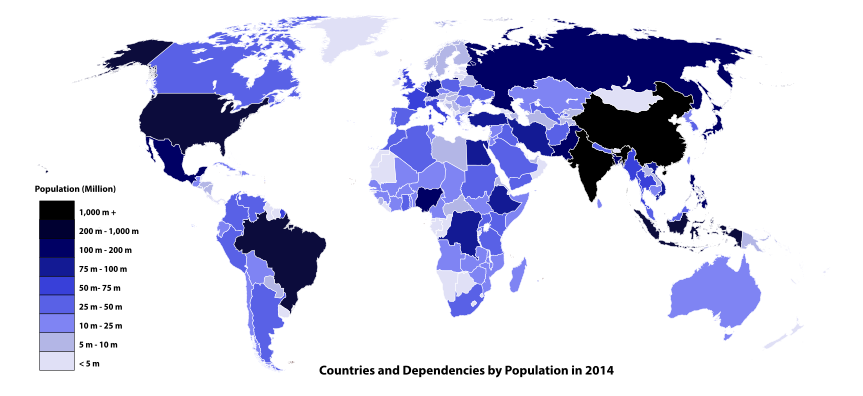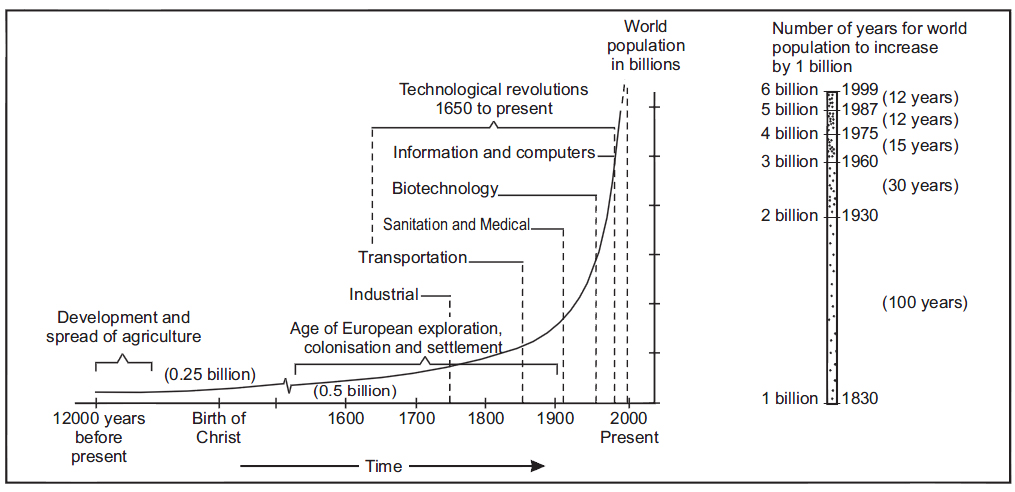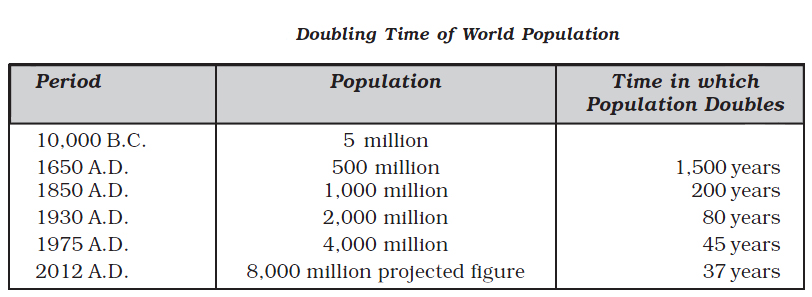This question is part of AP Human Geography and to answer this question we will break it down into different parts and understand it effectively. This way when you combine everything, you will get to know the genesis behind one of the most fundamental questions in human geography.
Distribution of human population on earth
When it comes to the question distribution of human population on earth – the important point to ask is “what are the factors behind the distribution of human population on earth?”. Because there is a strong correlation between where people live and factors like climate, physiographic terrain (landform), availability of natural resources like fresh water, minerals, fertile soil etc.
Although, it cannot be denied that humans do live in some of the most extreme and harsh environment such as:- hot Sahara desert of Africa and cold frigid regions of North Russia, Alaska, Antarctica, Greenland. However, most human reside at places which have moderate climate.
Below is a map that shows the global representation of population depending on region of concentration.
As you can see, that regions of south, southeast and eastern Asia, then areas of Europe and North, South America are some of the places that are heavily populated. In other words, these places have a “high population density”. Not to forget, these region also have moderate climate which is preferred by majority of the population on Earth.
World population growth
After the introduction of agriculture about 8,000 to 12,000 years ago, the size of population was small – roughly 8 million. In the first century A.D. it was below 300 million. During the 16th & 17th century, the world trade expanded and it let to population growth. Around 1750, during the beginning of the Industrial Revolution, the world population was 550 million.
World population exploded in the 18th century after the Industrial Revolution. It took more than a million years for the human population to attain the one billion mark. But it took only 12 years for it to rise from 5 billion to 6 billion.
Process of population change
There are three components of population change – births, deaths and migration.
Birth rate is the number of live births per thousand persons in a year. It is a major component of growth for any country’s economy.
Death rate is the number of deaths per thousand persons in a year. The main cause behind reduce in death rate is due to medical factors, such as the use of penicillin, sulfa drugs (discovered in 1935), and other antibiotics. These helped the elderly as well as the young by reducing the mortality rate.
Migration is the movement of people across regions and territories. Migration can be internal (within the country) or international (between the countries). It can be permanent, temporary or seasonal.
A same person is both an immigrant and an emigrant.
Immigration: Migrants who move into a new place are called Immigrants.
Emigration: Migrants who move out of a place are called Emigrants.
When people migrate from one place to another, it creates a push and pull factor.
The Push factors make the place of origin seem less attractive for reasons like unemployment, poor living conditions, political turmoil, unpleasant climate, natural disasters, epidemics and socio-economic backwardness.
The Pull factors make the place of destination seem more attractive than the place of origin for reasons like better job opportunities and living conditions, peace and stability, security of life and property and pleasant climate.
Effects of population change
For any economy to grow, a small increase in population is needed. However, population growth beyond a certain level can have an adverse effect like depletion of resources. At the same time, population decline is also a serious concern which reflects high death rates and reduced average life expectancy.
Now based on the theory of demographic transition – population of any place changes from high births and high deaths to low births and low deaths as society progresses from rural agricultural and illiterate society to urban industrial and literate society. These changes occur in stages which are collectively known as the demographic cycle.
First stage
In the first stage, the rate of fertility and mortality is high because people reproduce more to compensate for the deaths due to epidemics and variable food supply.
The population growth is slow and most of the people are engaged in agriculture where large families are an asset.
Life expectancy is low, people are mostly illiterate and do not possess any technological knowhow. 200 years ago all the countries of the world were in this stage.
Second stage
Fertility remains high in the beginning of second stage but it declines with time. This is accompanied by reduced mortality rate. Improvements in sanitation and health conditions lead to decline in mortality. If the birth rate is high and death rate is low, the net addition to population is high.
Third stage
In the last stage, both fertility and mortality decline considerably. The population is either stable or grows slowly. The population becomes urbanised, literate and has high technical knowledge and deliberately controls the family size.
This demonstrates people are to a great degree flexible and adaptable, alter with their surrounding environment. In the present day, different countries are at different stages of demographic transition.


